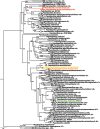Wild bees and their nests host Paenibacillus bacteria with functional potential of avail
- PMID: 30579360
- PMCID: PMC6303958
- DOI: 10.1186/s40168-018-0614-1
Wild bees and their nests host Paenibacillus bacteria with functional potential of avail
Abstract
Background: In previous studies, the gram-positive firmicute genus Paenibacillus was found with significant abundances in nests of wild solitary bees. Paenibacillus larvae is well-known for beekeepers as a severe pathogen causing the fatal honey bee disease American foulbrood, and other members of the genus are either secondary invaders of European foulbrood or considered a threat to honey bees. We thus investigated whether Paenibacillus is a common bacterium associated with various wild bees and hence poses a latent threat to honey bees visiting the same flowers.
Results: We collected 202 samples from 82 individuals or nests of 13 bee species at the same location and screened each for Paenibacillus using high-throughput sequencing-based 16S metabarcoding. We then isolated the identified strain Paenibacillus MBD-MB06 from a solitary bee nest and sequenced its genome. We did find conserved toxin genes and such encoding for chitin-binding proteins, yet none specifically related to foulbrood virulence or chitinases. Phylogenomic analysis revealed a closer relationship to strains of root-associated Paenibacillus rather than strains causing foulbrood or other accompanying diseases. We found anti-microbial evidence within the genome, confirmed by experimental bioassays with strong growth inhibition of selected fungi as well as gram-positive and gram-negative bacteria.
Conclusions: The isolated wild bee associate Paenibacillus MBD-MB06 is a common, but irregularly occurring part of wild bee microbiomes, present on adult body surfaces and guts and within nests especially in megachilids. It was phylogenetically and functionally distinct from harmful members causing honey bee colony diseases, although it shared few conserved proteins putatively toxic to insects that might indicate ancestral predisposition for the evolution of insect pathogens within the group. By contrast, our strain showed anti-microbial capabilities and the genome further indicates abilities for chitin-binding and biofilm-forming, suggesting it is likely a useful associate to avoid fungal penetration of the bee cuticula and a beneficial inhabitant of nests to repress fungal threats in humid and nutrient-rich environments of wild bee nests.
Keywords: 16S metabarcoding; American foulbrood; Anti-microbial activity; Bacterial genomics; Bee disease; Bioassays; European foulbrood; Paenibacterin; Pathogen vector; Phylogenomics.
Conflict of interest statement
Ethics approval and consent to participate
Animals investigated in this study are neither vertebrates, nor regulated invertebrates and were sampled on University of Würzburg property with consent of the manager of the Botanical Garden.
Consent for publication
Not applicable
Competing interests
The authors declare that they have no competing interests.
Publisher’s Note
Springer Nature remains neutral with regard to jurisdictional claims in published maps and institutional affiliations.
Figures



References
Publication types
MeSH terms
Substances
LinkOut - more resources
Full Text Sources

